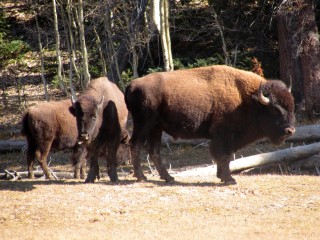
University Students Analyze Bison Impact on Ecosystem Health

Bison at the Grand Canyon's North Rim
Students in a Northern Arizona University undergraduate conservation biology class have been studying impacts of a prolific bison herd near the Grand Canyon’s North Rim. The class, started about 12 years ago by ecology professor Thomas Sisk, gives students the opportunity to do field research and contribute to land policy decisions. Grand Canyon National Park officials are in the process of creating an environmental impact statement for managing bison.
In 1906, Charles “Buffalo” Jones brought a herd of bison to northern Arizona to breed with cattle, thinking the offspring would produce a superior animal. A few years later, after a lackluster result, Jones sold off the bison he could capture and abandoned approximately 20 animals.
Since then, the herd has grown to an estimated 400, more than four times the optimum number for maintaining balanced ecosystems. Bison have trampled archaeological sites, affected water resources and damaged native plants through overgrazing and reducing plant diversity.
“The basic quality of the meadow ecosystems is changing because of grazing and some plants aren’t growing anymore,” said Lindsey Close. The environmental sciences major and her classmates spent multiple days camping working at the North Rim, evaluating plants and soils in areas populated by bison.
In addition to employing skills she learned in the classroom and laboratory to address a real-life environmental concern, Close said she learned a lot about the complexity of land management. To avoid being hunted, the herd travels to the national park, but the animals also live on state and forest service lands, with separate policies relating to managing bison.
Professor Robert Sanford said the opportunity for students to understand land management complexities is a valuable lesson in addition to learning the science. “It is a little bit rare that we are able to build experiential learning into our labs with the output of a true application. Students also have the exceptional opportunity to work in groups across multiple agencies and with different people and personalities,” Sanford said.
Martha Hahn, chief of science and resource management at Grand Canyon National Park, said her department is analyzing the student’s research. “The outcome of that analysis will be incorporated during the process of designing alternatives for the environmental impact statement,” Hahn said.
Contact Information
Theresa Bierer
Public Affairs Coordinator
Theresa.Bierer@nau.edu
Phone: 928-523-9495
Mobile: 928-699-2824















